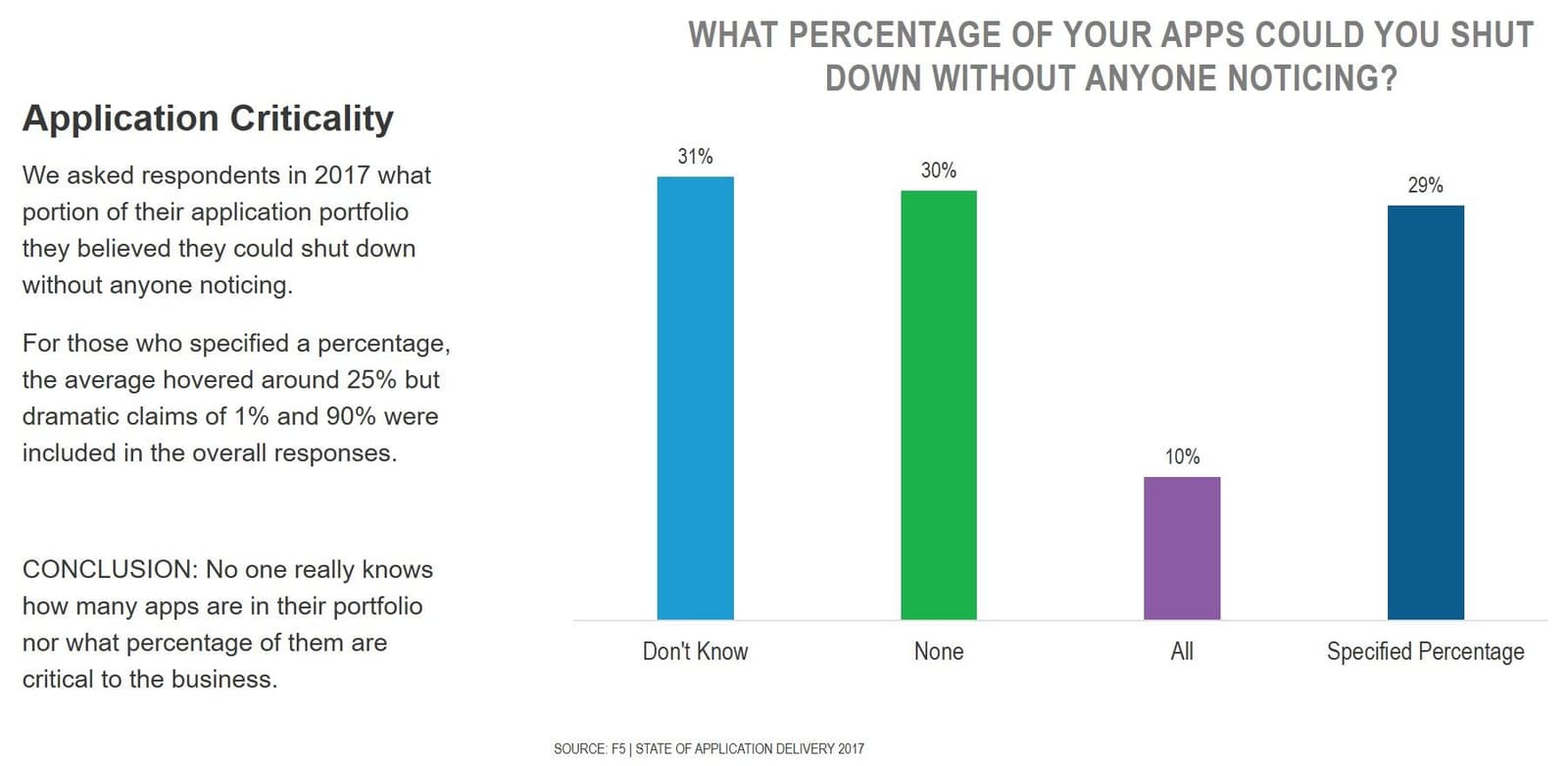Visibility is an often-cited challenge typically referring to the ability to inspect traffic, transactions, and errors that occur during an application's execution. But there's another, perhaps more critical, meaning to visibility at the business layer: a complete inventory of the corporate application portfolio.
In the first years of our State of Application Services (then called State of Application Delivery) research, we used to ask how many apps a respondent could shut down without anyone noticing.
Our intent was to discover just how many apps were really "critical" to the business, either for profit or productivity.
We don't ask anymore, because it turns out that most folks have absolutely no idea how many apps are in their portfolio let alone what percentage is critical.
Consider the answers to the question in 2017, in which 2104 respondents took to the time to give us a response.

This exercise seems to validate the observation of our own Kara Sprague, who has noted that "0% of customers can report with confidence the number of applications in their portfolio."
To be fair to customers - and the market at large - a significant portion of businesses today are multi-generational. The CIO, who probably should have a good idea, likely didn't exist as a position until the late 1990s. And those who sit in the CIO chair today are likely not the same person who sat in it just a decade earlier. Cataloging and inventorying application portfolios was not something we even talked about until well after the turn of the century.
And let's not discount the impact of acquisitions and mergers on application portfolios. Even if you did know the exact number of apps in your portfolio, what about the companies you've acquired - or the one that acquired you?
The reality is that only in the last few years has the market come to recognize just how important - how critical - applications are to their respective businesses. They are the capital in which we invest today with the hopes and expectation it will pay off in the future.
Which means we really ought to protect them better, because they are under attack. Constantly.
That task is made more difficult by the ability to find them, in the first place.
But find them we must. Because while we may be protecting our most "critical" applications, we aren't protecting them all. But we should be.
About the Author

Related Blog Posts

Build a quantum-safe backbone for AI with F5 and NetApp
By deploying F5 and NetApp solutions, enterprises can meet the demands of AI workloads, while preparing for a quantum future.

F5 ADSP Partner Program streamlines adoption of F5 platform
The new F5 ADSP Partner Program creates a dynamic ecosystem that drives growth and success for our partners and customers.

Accelerate Kubernetes and AI workloads with F5 BIG-IP and AWS EKS
The F5 BIG-IP Next for Kubernetes software will soon be available in AWS Marketplace to accelerate managed Kubernetes performance on AWS EKS.
F5 NGINX Gateway Fabric is a certified solution for Red Hat OpenShift
F5 collaborates with Red Hat to deliver a solution that combines the high-performance app delivery of F5 NGINX with Red Hat OpenShift’s enterprise Kubernetes capabilities.
F5 Silverline Mitigates Record-Breaking DDoS Attacks
Malicious attacks are increasing in scale and complexity, threatening to overwhelm and breach the internal resources of businesses globally. Often, these attacks combine high-volume traffic with stealthy, low-and-slow, application-targeted attack techniques, powered by either automated botnets or human-driven tools.
Phishing Attacks Soar 220% During COVID-19 Peak as Cybercriminal Opportunism Intensifies
David Warburton, author of the F5 Labs 2020 Phishing and Fraud Report, describes how fraudsters are adapting to the pandemic and maps out the trends ahead in this video, with summary comments.
